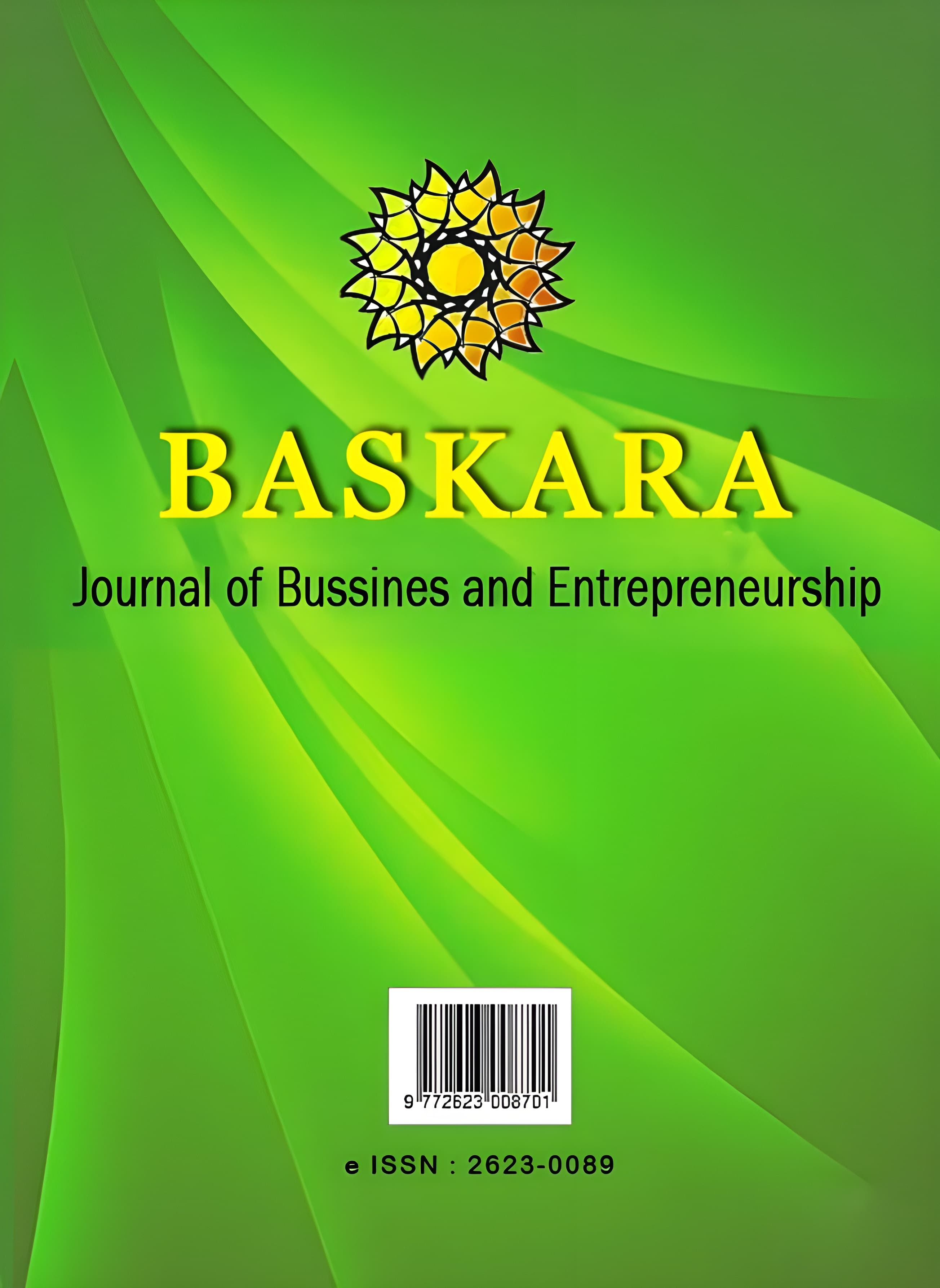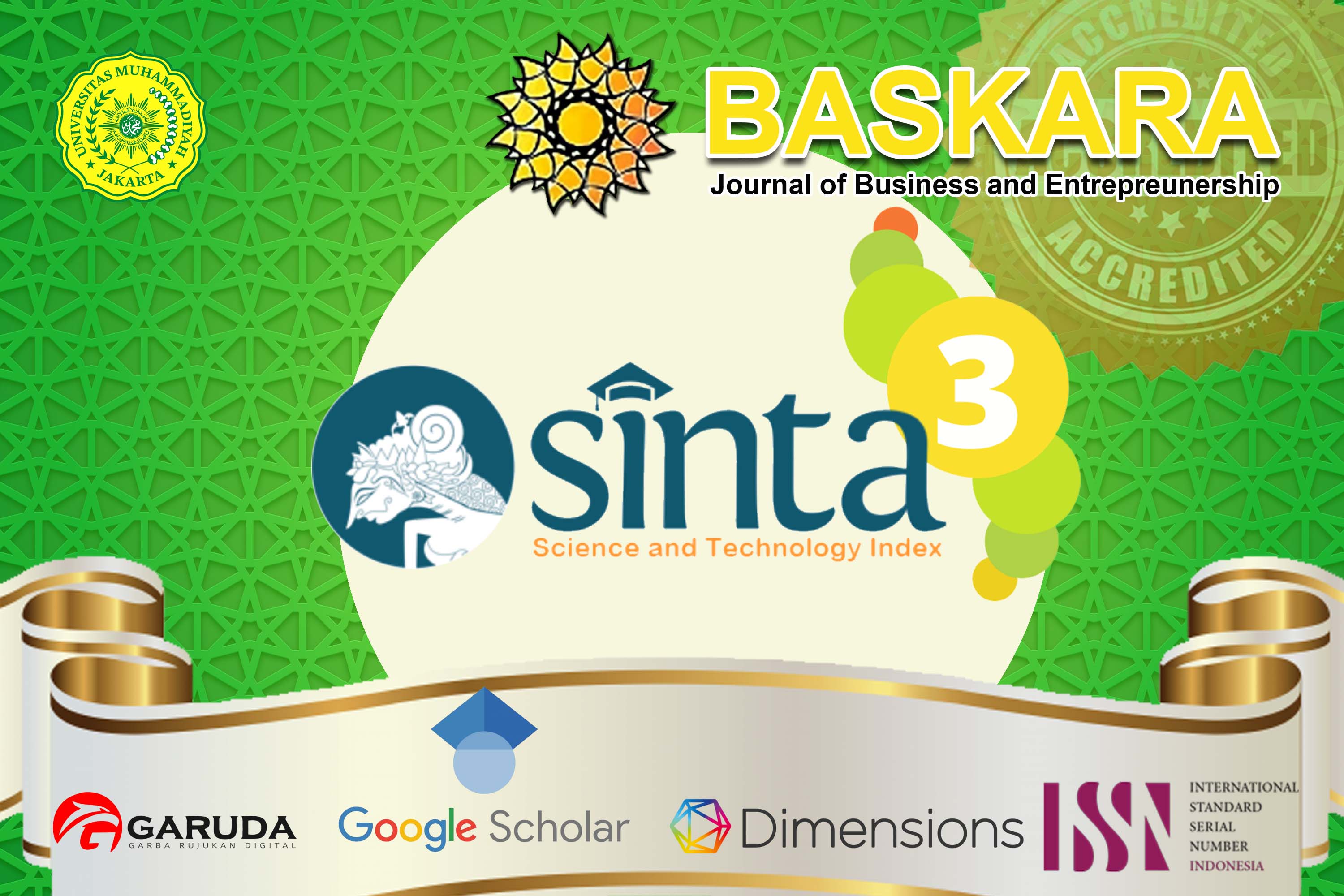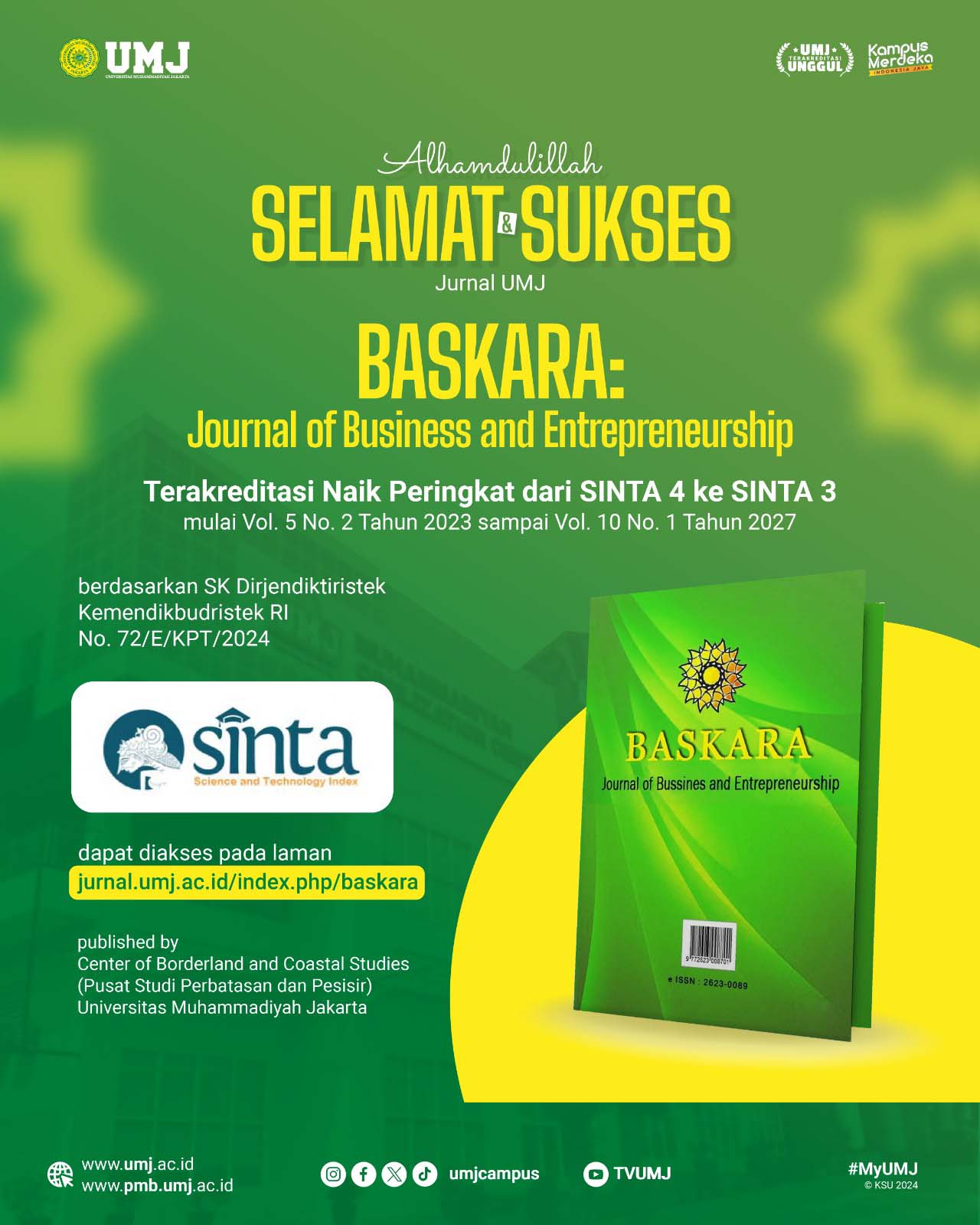Increasing the Competitiveness of Sweet Nutmeg and Papaya Products Owned by MSMEs in Cibeber Village, West Java Province, Indonesia
Abstract
This study aims to analyze strategies that can be applied to MSMEs producing candied nutmeg and papaya products in Cibeber Village to enhance their market competitiveness. A qualitative research method using in-depth interviews was conducted with 5 MSME actors and 5 regular consumers. The data collected was analyzed using SWOT analysis, with the Internal Factor Analysis Summary (IFAS) component to assess internal strengths and weaknesses, and the External Factor Analysis Summary (EFAS) to identify external opportunities and threats. The findings indicate that the most appropriate strategy is the ST (Strengths-Threats) strategy, which leverages internal strengths to address external threats such as intense competition and raw material price pressures. The novelty of this research lies in identifying the potential for MSMEs producing candied nutmeg and papaya to grow through improved packaging, product diversification, digital marketing, and more efficient supply chain management. The study recommends that MSMEs focus on utilizing technology for digital marketing, improving product quality, and expanding their market reach to mitigate external threats. Overall, this research offers new insights into marketing and product management strategies for local MSME development.References
Abdurohim, D. (2023). Analysis of MSME Challenges and opportunities in the digital era. International Journal of Economic Literature, 1(3), 285-292. https://injole.joln.org/index.php/ijle/article/view/26
Ahada, R., Dhahri, I., & Al-Shreifeen, I. A. (2024). Brand equity on consumer purchasing decisions. International Journal of Social and Education (INJOSEDU), 1(2), 330-339. https://btqur.or.id/index.php/injosedu/article/view/147
Chang-Munoz, E., Guarin-Garcia, A. F., Charris-Sevilla, Y., Gallego-Nicholls, J. F., Santis-Rojo, C., & Ortigosa-Blanch, A. (2023). Innovation Activities and Their Impact on Product Innovation Results: Evidence from a Sectorial Study. Sustainability, 15(8), 6459. https://doi.org/10.3390/su15086459
Farhana, M. (2012). Brand Elements Lead to Brand Equity: Differentiate or Die. Information Management and Business Review, 4(4), 223-233. DOI:10.22610/imbr.v4i4.983
Hermayanto, R. (2023). Effective Marketing Strategies in Business: Trends and Best Practices in the Digital Age. Jurnal Ad ministrare, 10(1), 61-72. DOI:10.26858/ja.v10i1.45101
Htet, T., Husni, M. F. D., & Apriliani, F. D. (2024). Crafting urban identities: Local cuisine and city branding in Indonesia and Myanmar. Journal of City: Branding and Authenticity, 2(1). https://doi.org/10.61511/jcbau.v2i1.2024.914
Ibrahim, I. D., Hamam, Y., Sadiku, R., & Ndambuki, Jm. (2022). Need for sustainable packaging: An overview. Polymers, 14(20), 4430. DOI:10.3390/polym14204430
Istijanto, & Purusottama, A. (2023). Is traditional media communication less effective than social media and personal selling for brand building? Empirical evidence from a cosmetics brand in Indonesia. Cogent Social Sciences, 9(2). https://doi.org/10.1080/23311886.2023.2276620
Janahi, N. A., Durugbo, C. M., & Al-Jayyousi, O. R.. (2021). Eco-innovation strategy in manufacturing: A systematic review. Cleaner Engineering and Technology, 5, 100343. https://doi.org/10.1016/j.clet.2021.100343
Mahrinasari, M. S., Bangsawan, S., & Sabri, M. Z. (2024). Local wisdom and Government's role in strengthening the sustainable competitive advantage of creative industries, Heliyon, 10(10). https://doi.org/10.1016/j.heliyon.2024.e31133
Nasri, S., Karnit, L., Shamandour, M., & Khnouf, V. (2023). The Effect of Brand Image on Customer Purchase Decision. Journal of Service Innovation and Sustainable Development, 4(1), 59-71. DOI:10.33168/SISD.2023.0106
Ningsih, S., & Tjahjono, B. (2024). Digital marketing innovation for MSMEs through chatgpt integration and management information systems: A technological transformation approach for competitive advantage. Jurnal Minfo Polgan, 13(1), 1033-1044. DOI:10.33395/jmp.v13i1.13924
Pascucci, F., Savelli, E. & Gistri, G. How digital technologies reshape marketing: evidence from a qualitative investigation. Italian Journal of Marketing, 2023. 27–58. https://doi.org/10.1007/s43039-023-00063-6
Popovic, I., Bossink, B., & Sijde, P. v. d. (2019). Factors influencing consumers' decision to purchase food in environmentally friendly packaging: What do we know and where do we go from here? Sustainability, 11(24), 1-22. DOI:10.3390/su11247197
Rehman, S. ul, Gulzar, R., & Aslam, W. (2022). Developing the Integrated Marketing Communication (IMC) through Social Media (SM): The Modern Marketing Communication Approach. Sage Open, 12(2). https://doi.org/10.1177/21582440221099936
Rita, P., Oliveira, T., & Farisa, T. (2019). The impact of e-service quality and customer satisfaction on customer behavior in online shopping. Heliyon, 5(10), e02690. https://doi.org/10.1016/j.heliyon.2019.e02690.
Saputro, W. W., Khatami, Z., & Akbar, S. (2023). Marketing Segmentation for Increasing Sales Volume in Islamic Economic Perspective. Journal of Economicate Studies (JoES), 7(2), 16-27. https://doi.org/10.32506/joes.v7i2.853
Shava, H. (2021). The relationship between service quality and customer satisfaction in the South African mobile network telecommunications industry. Journal of International Studies, 14(2), 70-83. DOI:10.14254/2071-8330.2021/14-2/5
Silva, F. M. d., Oliveira, E. A. d. A. Q., & Moraes, M. B. d. (2016). Innovation development process in small and medium technology-based companies. RAI Revista de Administração e Inovação, 13(3), 176-189. https://doi.org/10.1016/j.rai.2016.04.005
Szczyrba, A., & Szataniak, M. (2023). Decoding Consumer Preferences in Food Packaging with the Kano Model. System Safety Human-Technical Facility- Environment, 5(1), 83-92. DOI:10.2478/czoto-2023-0010
Taufik, A., Santoso, S., Fahmi, M. I., & Restuanto, F. (2022). The Role of Service and Product Quality on Customer Loyalty. Journal of Consumer Sciences, 7(1), 68-82. DOI:10.29244/jcs.7.1.68-82
Undang-Undang Nomor 20 Tahun 2008 tentang Usaha, Mikro, Kecil, dan Menengah.
Wandosell, G., Parra-Merono, M. C., Alcayde, A., & Banos, R. (2020). Green Packaging from Consumer and Business Perspectives. Sustainability, 13(3), 1356. https://doi.org/10.3390/su13031356
Yang, J., & Battocchio, A. F. (2020). Effects of transparent brand communication on perceived brand authenticity and consumer responses. Journal of Product & Brand Management, 30(8), 1176-1193. DOI:10.1108/JPBM-03-2020-2803
Wang, H., Ab Gani, M. A. A., & Liu, C. (2023). Impact of Snack Food Packaging Design Characteristics on Consumer Purchase Decisions. Sage Open, 13(2). https://doi.org/10.1177/21582440231167109.
Wang, E. S. T. (2013). The influence of visual packaging design on perceived food product quality, value, and brand preference. International Journal of Retail & Distribution Management, 41(10). DOI:10.1108/IJRDM-12-2012-0113
Yeo, S. F., Tan, C. L., Lim, K. B., & Khoo, Y-H. (2020). Product Packaging: Impact on Customers’ Purchase Intention. International Journal of Business and Society, 21(2), 857-864. DOI:10.33736/ijbs.3298.2020
Yung X. Y. (2023). The Positive Role of Packaging in Consumer Behavior. Advances in Economics Management and Political Sciences, 63(1), 293-300. DOI:10.54254/2754-1169/63/20231445
Downloads
Published
Issue
Section
License
Copyright (c) 2025 BASKARA : Journal of Business and Entrepreneurship

This work is licensed under a Creative Commons Attribution-NonCommercial 4.0 International License.
In order for Baskara: Journal of Business and Entrepreneurship to publish and disseminate research articles, we need publishing rights (transfered from author(s) to publisher). This is determined by a publishing agreement between the Author(s) and Baskara Journal. This agreement deals with the transfer or license of the copyright of publishing to Baskara: Journal of Business and Entrepreneurship, while Authors still retain significant rights to use and share their own published articles. Baskara : Journal of Business and Entrepreneurship supports the need for authors to share, disseminate and maximize the impact of their research and these rights, in any databases.
As a journal Author, you have rights for a large range of uses of your article, including use by your employing institute or company. These Author rights can be exercised without the need to obtain specific permission. Authors publishing in Baskara : Journal of Business and Entrepreneurship have wide rights to use their works for teaching and scholarly purposes without needing to seek permission, including:
- use for classroom teaching by Author or Author's institution and presentation at a meeting or conference and distributing copies to attendees;
- use for internal training by author's company;
- distribution to colleagues for their reseearch use;
- use in a subsequent compilation of the author's works;
- inclusion in a thesis or dissertation;
- reuse of portions or extracts from the article in other works (with full acknowledgement of final article);
- preparation of derivative works (other than commercial purposes) (with full acknowledgement of final article);
- voluntary posting on open web sites operated by author or author’s institution for scholarly purposes.
Copyright Transfer Agreement for Publishing (Publishing Right)
The Authors who submit manuscript has to understand that if accepted for publication, mean that all copyright and publishing right of the article shall be assigned/transferred to Baskara: Journal of Business and Entrepreneurship as assigned publisher.
- CC BY-NC: This license allows reusers to distribute, remix, adapt, and build upon the material in any medium or format for noncommercial purposes only, and only so long as attribution is given to the creator.
It includes the following elements:
BY ![]() – Credit must be given to the creator
– Credit must be given to the creator
NC ![]() – Only noncommercial uses of the work are permitted
– Only noncommercial uses of the work are permitted
Baskara (C) Copyright (2022):
BASKARA: Journal of Business and Entrepreneurship by https://jurnal.umj.ac.id/index.php/baskara
is licensed under a Creative Commons Attribution-NonCommercial 4.0 International License








